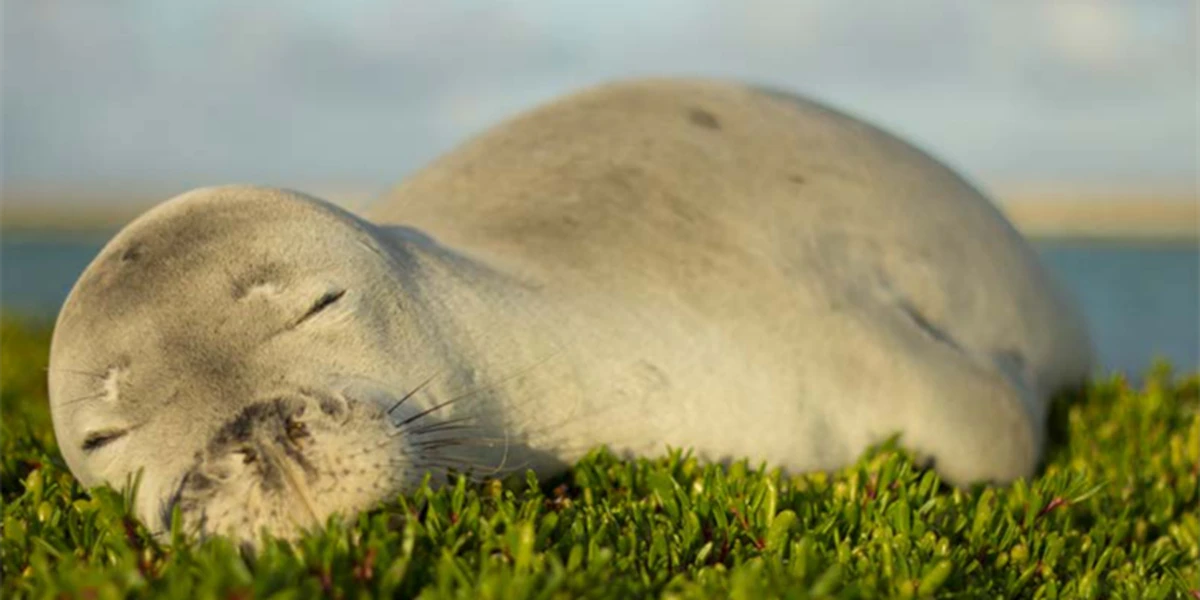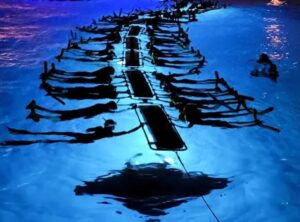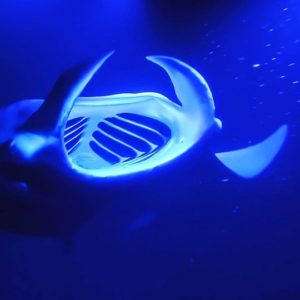NOAA Fisheries on the rare Hawaiian Monk Seal. Our manta ray tours are the best way to experience viewing the beautiful marine life off the coast of Kona.
About the Species
The Hawaiian monk seal is one of the most endangered seal species in the world. The population overall had been declining for six decades and current numbers, though increasing, are only about one-third of historic population levels. Importantly, however, the current upward trend is in part due to NOAA Fisheries recovery efforts.
Hawaiian monk seals are found in the Hawaiian archipelago which includes both the main and Northwestern Hawaiian Islands and rarely at Johnston Atoll which lies nearly 1,000 miles southwest of Hawai’i. These monk seals are endemic to these islands, occurring nowhere else in the world. Hawaiian monk seals are protected under the Endangered Species Act, the Marine Mammal Protection Act, and State of Hawai’i law.
The Hawaiian monk seal is one of NOAA Fisheries’ Species in the Spotlight.
Rocky, the Famous Hawaiian Monk Seal
Rocky became famous in 2017 when she had a pup on a busy beach in Waikiki on the island of Oʻahu. She returned to Kauaʻi on July 14, 2018, and two days later, she was observed with a new pup.
Population Status
The population is estimated to be around 1,400 seals—about 1,100 seals in the Northwestern Hawaiian Islands and 300 seals in the main Hawaiian Islands.
A prolonged decline of the Hawaiian monk seal population in the NWHI occurred after the late 1950s, lasting until very recently. While individual subpopulations increased or decreased during that time, the total number of seals in the NWHI declined. Although this decline means that a full recovery of the species is a long way off, there have been some relatively recent, encouraging developments, including:
- Apparent recolonization and significant growth of the main Hawaiian Islands monk seal subpopulation from low numbers to approximately 300 over the past two or more decades.
- Overall species population growth of 2 percent each year between 2013 and 2019.
- Promising advances in juvenile seal survival enhancement research.
The decline that occurred in the NWHI has been attributed to a number of factors at various regions and time periods. However, low juvenile survival, likely related to inadequate prey availability, had been the primary driver of the decline during the past 25 years.
Appearance
Newborn monk seal pups are born black, while weaned pups and older seals are dark gray to brown on their back and light gray to yellowish brown on their belly.
Monk seals undergo a “catastrophic molt” about once per year, where they shed the top layer of their skin and fur (similar to elephant seals). Seals that spend a long time at sea foraging can grow algae on their fur. Those that look green haven’t molted recently and may be getting ready to shed into a new silvery coat.
Most Hawaiian monk seals have unique natural markings, such as scars or natural bleach marks (white spots), on their fur which help identify them. Personnel authorized by NOAA Fisheries often apply identification tags to their rear flippers. Tagging and tracking used in combination with identification of unique markings enable long-term monitoring of individuals.
Male and female monk seals are similar in size. The only way to confirm whether a seal is female or male is by looking at its belly.
Behavior and Diet
Hawaiian monk seals are “generalist” feeders, which means they eat a wide variety of foods depending on what’s available. They eat many types of common fishes, squids, octopuses, eels, and crustaceans (crabs, shrimps, and lobsters). Diet studies indicate that they forage at or near the seafloor and prefer prey that hide in the sand or under rocks. They do not target most of the locally popular gamefish species such as ulua (giant trevally), pāpio (baby ulua), and ‘ō‘io (bonefish).
Hawaiian monk seals can hold their breath for up to 20 minutes and dive more than 1,800 feet; however, they usually dive an average of 6 minutes to depths of less than 200 feet to forage at the seafloor.
Hawaiian monk seals are mostly solitary and don’t live in colonies like sea lions or other seals. But they do sometimes lie near each other—usually not close enough to make physical contact—in small groups. They usually sleep on beaches, sometimes for days at a time. They also occasionally sleep in small underwater caves.
Monk seals do not migrate seasonally, but some seals have traveled hundreds of miles in the open ocean. Individual seals often frequent the same beaches over and over, but they do not defend territories.
Where They Live
Hawaiian monk seals are found throughout the entire Hawaiian archipelago, a distance of 1,500 miles from Kure Atoll (Hōlanikū) in the northwest to Hawaiʻi Island in the southeast. The majority of Hawaiian monk seals (about 1,100 individuals) live in the Northwestern Hawaiian Islands, and a much smaller population (about 300) lives in the main Hawaiian Islands. There have also been rare sightings of Hawaiian monk seals, as well as a single birth, at Johnston Atoll, the closest atoll southwest of the Hawaiian Islands.
Monk seals live in warm, subtropical waters and spend two-thirds of their time at sea. They use the waters surrounding atolls and islands and areas farther offshore on reefs and submerged banks; they also use deepwater coral beds as foraging habitat. When on land, monk seals haul-out to rest, molt, give birth and nurse on sand, coral rubble, and volcanic rock shorelines. They generally prefer sandy, protected beaches surrounded by shallow waters for pupping.
Lifespan & Reproduction
Monk seals can live to over 30 years of age, but few live that long. Monk seals mate in the water. The youngest documented female to give birth was 4 years old, but typically females begin reproducing at age 5 to 6 in the main Hawaiian Islands and age 7 to 10 in the Northwestern Hawaiian Islands.
Threats
Food Limitation
Limited food intake by juvenile seals was a major factor driving the population decline in the Northwestern Hawaiian Islands for many years. However, improved survival of young seals in recent years seems to be driving the positive abundance trends. . In the NWHI, seals must compete for food with large populations of other apex predators, such as large jacks (carangids) and sharks. Shifts in ecosystem productivity, caused by global climate change and/or cyclical changes, may also contribute to food limitation.
Shark Predation
Since the late 1990s, predation by Galapagos sharks on pre-weaned and recently weaned seal pups has been a chronic and significant cause of injury and mortality specific to French Frigate Shoals (Lalo) in the Northwestern Hawaiian Islands. This is a unique type of seal mortality that appears to result from atypical behavior of a limited number of Galapagos sharks that prey on pups in nearshore waters, often in just a few feet of water. Learn more about our monk seal pup protection efforts at French Frigate Shoals (Lalo).
Entanglement
Hawaiian monk seals have one of the highest documented entanglement rates of any pinniped species, and pups and juveniles are the most often entangled. Marine debris and derelict fishing gear are chronic forms of pollution affecting monk seal habitat, particularly in the Northwestern Hawaiian Islands. The number of monk seals found entangled each year has generally remained unchanged. Undertaken by various agencies within NOAA, the U.S. Coast Guard, and other partners, marine debris removal efforts have extracted over 800 metric tons of debris in the NWHI since 1996, but accumulation rates of marine debris appear to remain constant. Learn more about our Marine Debris Research and Removal in the Northwestern Hawaiian Islands.
Male Seal Aggression
A significant cause of female and juvenile monk seal mortality—and overall population decline—during the 1980s and early 1990s was by aggression from multiple male seals (especially at Laysan (Kamole) and Lisianski (Kapou) Islands). In other instances, single males have aggressively attacked and lethally injured recently weaned pups at French Frigate Shoals (Lalo) and Kure Atoll (Hōlanikū). NOAA Fisheries found that removal of specific aggressive males appears to be an effective method to address this threat. Other interventions include hazing of the aggressor, translocating young seals away from areas with the aggressive males, and treating injured seals as appropriate. Male aggression continues to be a concern, even though it tends to be episodic, geographically limited, and largely manageable provided necessary resources are available.
Habitat Loss
The loss of terrestrial habitat is a significant issue in the Northwestern Hawaiian Islands, which has mostly low-lying atolls (many islands less than 6.5 feet above sea level) subject to beach loss from storm erosion and sea level rise. Some significant habitat loss—such as the disappearance of Whale-Skate and Trig Islands at French Frigate Shoals (Lalo) which were previously primary pupping sites—has already occurred, and sea level rise over the longer term may threaten a large portion of the resting and pupping habitat in the NWHI.
Fishery Interactions
Since 1990, fishery management measures have eliminated interactions with monk seals in U.S.-managed commercial fisheries in the Northwestern Hawaiian Islands. But interactions in nearshore recreational and subsistence fisheries have occurred in the main Hawaiian Islands. Between 1976 and 2018, there have been up to180 documented hookings and entanglements in gill nets, which resulted in 19 monk seal deaths. However, deaths from hookings would be higher were it not for stranding response and other interventions by NOAA Fisheries. Expert fishermen, together with state and federal wildlife managers developed best practice guidance for fishermen that participate in the three main Hawaiian Islands nearshore fisheries that may interact with monk seals: spearfishing, shorecasting, and gillnet fishing.
Disease and Contaminants
One of the primary diseases of concern to Hawaiian monk seals is toxoplasmosis, a leading cause of seal death in the main Hawaiian Islands. The first case of toxoplasmosis in a Hawaiian monk seal was identified in 2004, and in sum there have been at least 13 known deaths of Hawaiian monk seals caused directly by this parasite, with two clusters of cases detected in 2018 and 2020. Seals with toxoplasmosis are usually found dead and not all carcasses are found, so it is likely that more seals have been affected than are reported. There are more cases of toxoplasmosis in females than males, which means that this disease has direct impacts on the species’ reproductive potential and population growth. Unlike toxoplasmosis, which is a clear and present disease threat, morbillivirus (e.g., phocine distemper virus) and West Nile Virus are of particular interest despite the fact that neither have been detected in wild Hawaiian monk seals to-date. Because Hawaiian monk seals do not have antibodies to morbilliviruses or West Nile Virus, their introduction could have a substantial effect on the population. The focus is therefore in early detection and prevention, and Hawaiian monk seals have been routinely vaccinated against morbillivirus since 2016. Other infections that are sometimes detected in Hawaiian monk seals include Brucella, herpesvirus, and Leptospira, and their significance varies but is generally not thought to have population level impacts. Persistent organic pollutants and other contaminants in Hawaiian monk seals are below the levels that have been identified as causing health effects in other marine mammal species.
Human-Seal Interactions
Intentional feeding, disturbance of sleeping or resting seals (including dog attacks), boat or vehicle strikes, and other direct human interactions, such as swimming with juvenile seals, has become a serious concern for the main Hawaiian Islands population. Beaches that are popular for human recreation are increasingly used by monk seals for “hauling out” (resting) and molting, and some female monk seals are also pupping on popular recreational beaches. During these pupping events, mother-pup pairs remain on the beach to nurse for up to 7 weeks, at which time they’re particularly vulnerable to human disturbance. This also presents a serious human safety concern, as mother seals are protective and aggressive. Human-seal interactions pose both a threat to human and seal safety and have necessitated the relocation of “conditioned” seals to remote locations in some cases.
Intentional Killing
Intentional killing of seals is an extreme example of negative human impacts in the main Hawaiian Islands. As of 2018, at least four seals have died from apparent gunshots (including one pregnant female) and eight from blunt force trauma. These events are ongoing and of serious concern.









